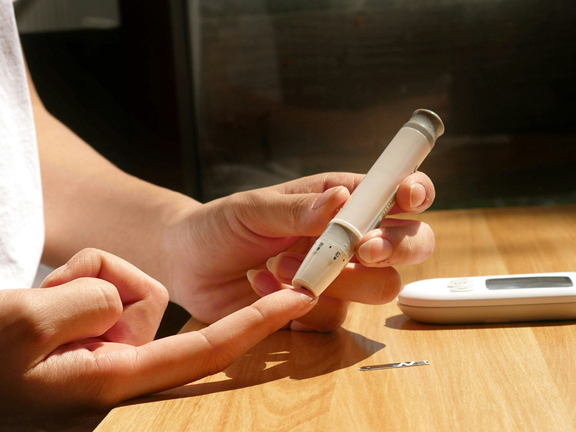Living with diabetes requires consistent care—and that includes taking extra precautions with your feet. High blood sugar levels can damage the nerves and blood vessels in your feet, putting you at risk for serious complications.
How Diabetes Affects Your Feet
When blood sugar levels stay high over time, it can lead to nerve damage (called diabetic neuropathy) and poor circulation. These issues often show up first in your feet. You may experience:
-
Tingling or “pins and needles” sensation
-
Numbness or reduced ability to feel pain, heat, or pressure
-
Sores or injuries you don’t notice right away
If left untreated, even a small blister or cut can turn into a serious infection. In severe cases, this can lead to amputation.

Warning Signs of Poor Blood Flow
Poor circulation can sneak up on you, so it’s important to watch for these signs:
-
Aching legs or feet, especially during exercise
-
Restless legs or pain at night
-
Swollen, blue, or discolored feet
-
Sores that don’t heal
-
Dry, cracked skin on your feet
If you notice any of these, it’s time to check in with your doctor.
Make Foot Checks Part of Every Appointment
Every time you see your doctor, remove your shoes and socks so they can check your feet. This quick step can catch problems early and prevent serious complications.orem ipsum dolor sit amet, consectetur adipiscing elit. Ut elit tellus, luctus nec ullamcorper mattis, pulvinar dapibus leo.
Daily Foot Care Tips for People with Diabetes
Caring for your feet doesn’t have to be complicated, but it must be consistent. Here’s what you can do every day:
1. Inspect Your Feet
-
Look for cuts, cracks, blisters, redness, or dry skin between your toes or on the soles
-
Use a mirror or ask someone for help if you have trouble seeing
2. Wash and Dry Carefully
-
Use mild soap and warm (not hot) water
-
Test the water with your wrist or elbow first
-
Dry thoroughly, especially between your toes
-
Do not soak your feet—it can dry your skin too much
3. Moisturize (But Not Between Toes)
-
Apply lotion or cream to the tops and bottoms of your feet daily
-
Avoid putting lotion between your toes to prevent fungal infections
4. Trim Toenails the Right Way
-
Use an emery board to gently file nails straight across
-
Avoid cutting toenails if possible, especially if your vision is poor or you have thick nails
Footwear and Professional Care Matter
What you wear on your feet is just as important as how you care for them. Always shake out your shoes and socks before putting them on to avoid any small objects that might injure your feet. Choose well-fitting shoes that fully cover and protect your feet—avoid sandals, open-toed, or high-heeled shoes, and never go barefoot, even indoors.
When it comes to socks, look for cotton or wool blends that help keep your feet dry. Some of the best options are made from spun nylon, such as those from the Thorlo brand, which wick away moisture and provide extra cushioning. If your feet tend to get cold, warmer socks are fine, but don’t use heating pads or hot water bottles unless your doctor specifically advises it—these can easily cause burns if you have reduced sensation.
Avoid trying to treat corns, calluses, or warts at home. Products like razor blades, liquid removers, corn plasters, and wart compounds can damage your skin and lead to infections. It’s always safest to see a podiatrist for any foot concerns.
Foot care is an essential part of managing diabetes, and partnering with a foot doctor ensures you’re doing everything possible to protect your health. Every person with diabetes should see a podiatrist at least once a year, or more often if foot problems already exist.